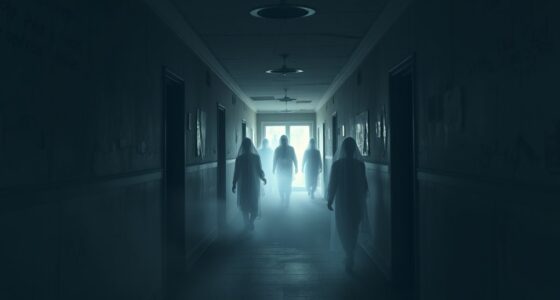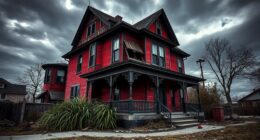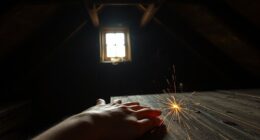To analyze audio for paranormal evidence, start with high-quality recording equipment and noise-canceling headphones. Review your recordings critically, classifying any Electronic Voice Phenomena (EVP) into Class A, B, or C based on clarity. Always maintain the integrity of original files by avoiding editing, as this could distort sounds. Document context, findings, and peer insights to enhance reliability. With these techniques, you can better interpret audio evidence and uncover hidden anomalies waiting to be discovered.
Key Takeaways
- Use high-definition recording devices to ensure clear capture of EVPs, minimizing background noise and enhancing audio quality.
- Classify EVPs into Class A, B, and C categories based on clarity, documenting timestamps for reference during analysis.
- Maintain original recordings without edits to preserve integrity and provide a reliable basis for validation by skeptics.
- Analyze audio in a quiet environment, utilizing sound editing software like Audacity for detailed waveform visualization and anomaly detection.
- Engage in peer review to cross-check findings, encourage constructive feedback, and ensure a thorough analysis process.
Gathering Equipment for Audio Analysis
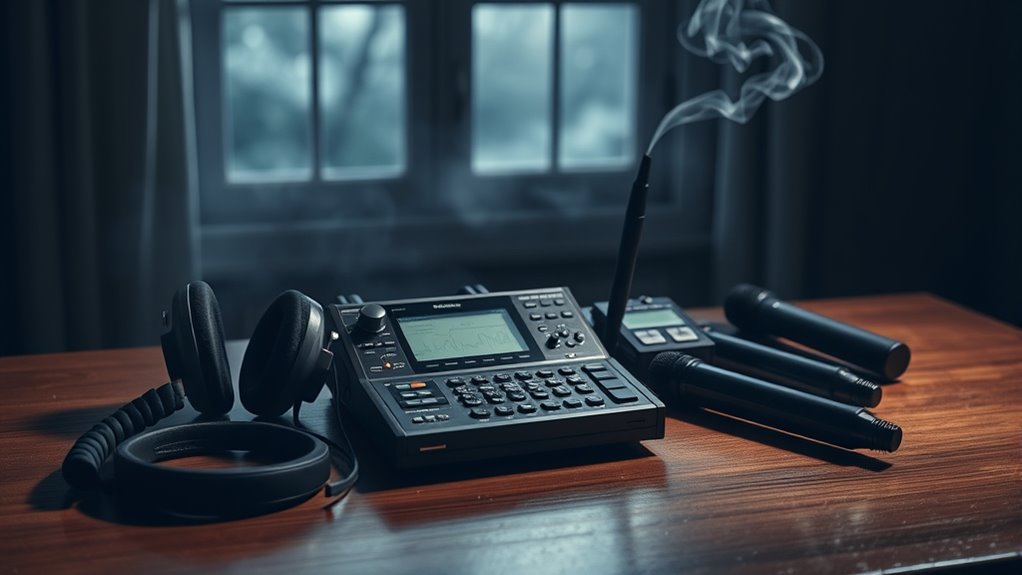
When diving into audio analysis for paranormal evidence, having the right equipment is essential. Start with a high-definition recording device to capture clear Electronic Voice Phenomena (EVP). This clarity is vital for effective audio editing later on.
Don’t forget noise-canceling headphones; they’ll help you focus during analysis sessions, allowing for a more accurate evaluation of sounds. Utilize free sound editing software like Audacity to visualize audio waveforms and isolate any anomalies.
Always create a backup of your original files to maintain evidence integrity. Document the context of your recordings—date, time, and environmental conditions—to aid in cross-referencing with other findings.
Finally, maintain a detailed audio log to track timestamps of your discoveries and keep your evidence organized.
Best Selling Audio Equipment for Ghost Hunting

When you’re gearing up for ghost hunting, choosing the right audio equipment can make all the difference.
The SBox SpiritBox and P-SB7 Spirit Box stand out for their ability to capture potential EVP, while devices like the SpiritPod X1 and motion-detecting Flashing Balls help alert you to paranormal activity.
Let’s explore these top picks to enhance your audio analysis during investigations.
Top Spirit Box Choices
Ghost hunting enthusiasts have a variety of spirit box options to choose from, each designed to enhance your paranormal investigations. These devices can help you capture audio data and potentially reveal ghostly voices during your sessions. Here are some top picks:
| Spirit Box | Price |
|---|---|
| SBox SpiritBox FM/AM Scanner | $109.00 |
| HexCom Word Generator | $129.99 |
| P-SB7 Spirit Box (New Model) | $129.99 |
| SpiritPod X1 | $79.99 |
| Touch Activated Flashing Balls | $14.99 |
Selecting the right spirit box can improve your chances of collecting credible paranormal evidence. Each device offers unique features, catering to various investigation styles and preferences.
Essential Audio Recording Devices
Choosing the right spirit box is just one part of your ghost hunting toolkit. To capture potential evidence effectively, investing in quality audio recording devices is vital.
The SBox SpiritBox FM/AM Scanner, priced at $109.00, is popular for its ability to capture spirit communication through radio frequencies. The P-SB7 Spirit Box at $129.99 enhances EVP collection with user-friendly features. For generating words interpreted as responses, the HexCom Word Generator is a solid choice at $129.99.
Affordable options like the SpiritPod X1 at $79.99 and Touch Activated Flashing Balls can also detect paranormal activity.
Reviewing Audio Evidence

When reviewing audio evidence, it’s essential to classify EVPs into categories like Class A or Class C to help you assess their clarity.
You also need to take into account the context surrounding each anomaly, as it can provide valuable insights into what you’re hearing.
EVP Classification Categories
As you explore the world of Electronic Voice Phenomena (EVP), understanding the classification categories is vital for evaluating audio evidence effectively.
EVPs are classified into three main categories: Class A, Class B, and Class C. Class A recordings feature a clear, ghostly voice that’s easy to understand, making them compelling evidence of paranormal activity.
Class B audio clips contain recognizable words but may require context or repeated listening to grasp fully.
Finally, Class C EVPs are often faint or ambiguous, leading to skepticism as they can easily be mistaken for background noise.
To accurately classify these recordings, you’ll need to listen carefully, document timestamps, and compare them with background audio to verify their authenticity.
Importance of Context
Understanding the importance of context in reviewing audio evidence is essential for accurate interpretation. When you analyze audio tracks, consider the date, time, and environmental conditions during the recording. This information helps eliminate false positives.
Include a few seconds of background noises before and after any anomalous sounds to determine if they’re isolated incidents or part of a larger pattern. Keep original recordings unedited to preserve their integrity and avoid misleading artifacts.
Cross-reference your findings with visual evidence and time stamps to strengthen the credibility of your analysis. Finally, document all your findings in an audio review log, allowing for systematic tracking and easier sharing with peers for verification.
Context truly makes a difference in your paranormal investigations.
Understanding Audio Anomalies
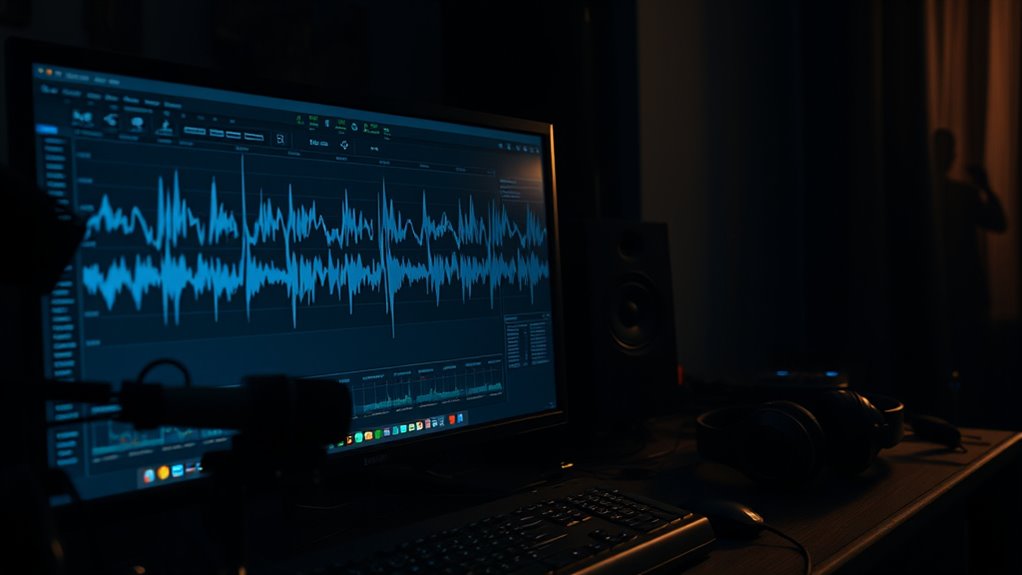
Audio anomalies, often known as Electronic Voice Phenomena (EVP), can be intriguing yet perplexing, especially since they manifest as unexplained voices captured during recordings. Understanding these anomalies requires attention to detail and the right equipment. High-quality audio gear is essential for minimizing noise and capturing clear EVP.
| Category | Description |
|---|---|
| Class A EVP | Clear and easily understood voices |
| Class B EVP | Somewhat intelligible, requires effort |
| Class C EVP | Nearly indistinguishable sounds |
| Matrixing | Misinterpretation of random sounds |
To analyze effectively, listen in distraction-free settings, use noise reduction techniques, and document findings meticulously. This approach enhances your ability to identify genuine anomalies.
Importance of Context in Audio Analysis

When analyzing audio for paranormal evidence, context plays a pivotal role in ensuring accurate interpretations. Understanding the time, date, and environmental conditions during your recording helps you gauge the significance of any anomalies.
For instance, capturing electronic voice phenomena (EVP) requires you to include a few seconds of audio before and after the sound, determining if it’s part of a pattern or an isolated incident. Cross-referencing these findings with timestamps and other evidence, like video footage, strengthens your conclusions.
Documenting background noise and potential distractions during recording can reveal false positives, enhancing your analysis. Finally, maintaining a detailed audio review log with contextual details supports systematic tracking and thorough peer review of your findings.
Risks of Editing Audio Recordings

When you edit audio recordings, you risk altering the original sound and inadvertently introducing artifacts that can skew your analysis.
It’s essential to preserve the integrity of your recordings, as any changes can complicate the identification of genuine evidence.
Editing Software Pitfalls
Editing audio recordings can be a double-edged sword, as it often risks compromising the integrity of your evidence. While editing software can enhance recordings, overusing features can exaggerate non-voice sounds, leading you to misinterpret mundane noises as a voice phenomenon.
Additionally, editing may obscure essential contextual information, making it tough to determine if an anomalous sound is part of a pattern or an isolated incident. Subjective selection of noise areas for enhancement can yield inconsistent outcomes, hindering objective comparisons.
Relying on editing software to recover faint signals may mislead your analysis, which is why preserving unaltered original files is imperative. Accurate conclusions about paranormal activity depend on maintaining the authenticity of your recordings.
Preservation of Original Recordings
Many investigators overlook the importance of preserving original recordings, often underestimating the risks associated with editing.
Editing can permanently alter sound quality, potentially removing essential context needed for analyzing electronic voice phenomena (EVP). Enhancements might create false sounds or distortions, leading to misinterpretations and undermining evidence credibility.
It’s crucial to maintain unedited original recordings to preserve their integrity, allowing for scrutiny by skeptics. Always save copies of your recordings before manipulation, ensuring the original evidence stays intact for future reference.
Additionally, document the time stamps and include a few seconds of audio before and after anomalous sounds. This context is important for understanding the nature of the recorded phenomena, helping you analyze the evidence accurately.
Evidence Review Process

To effectively analyze audio for paranormal evidence, you’ll want to conduct the review in a quiet, distraction-free environment. This guarantees you can focus on the audio evidence without interruptions.
To effectively analyze audio for paranormal evidence, ensure a quiet, distraction-free environment for focused review.
Here’s how to streamline your evidence review process:
- Transfer digital audio files to a computer for easier access.
- Document the medium, date, and time for each audio file to maintain accurate records.
- Thoroughly review each file, taking your time to spot any anomalies or significant findings, like electronic voice phenomena (EVP).
- Involve at least two people in the review process for verification and additional insights.
- Use headphones for a more detailed listening experience.
Tools for Audio Analysis

When analyzing audio for paranormal evidence, having the right tools at your disposal can greatly enhance your findings. Start by using a free audio editor like Audacity or AVS Audio Editor, which allows you to visualize waveforms and isolate anomalies.
It’s essential to employ high-definition audio recording equipment to capture potential electronic voice phenomena (EVP) clearly, as lower quality gear increases background noise. While listening to the recording, use quality headphones to minimize external interference. You might consider noise-canceling headphones, but be cautious, as they can obscure faint EVP.
Finally, document all findings meticulously in an audio review log, noting timestamps for anomalies and context, which helps in cross-referencing with other evidence sources.
Engaging in Peer Review
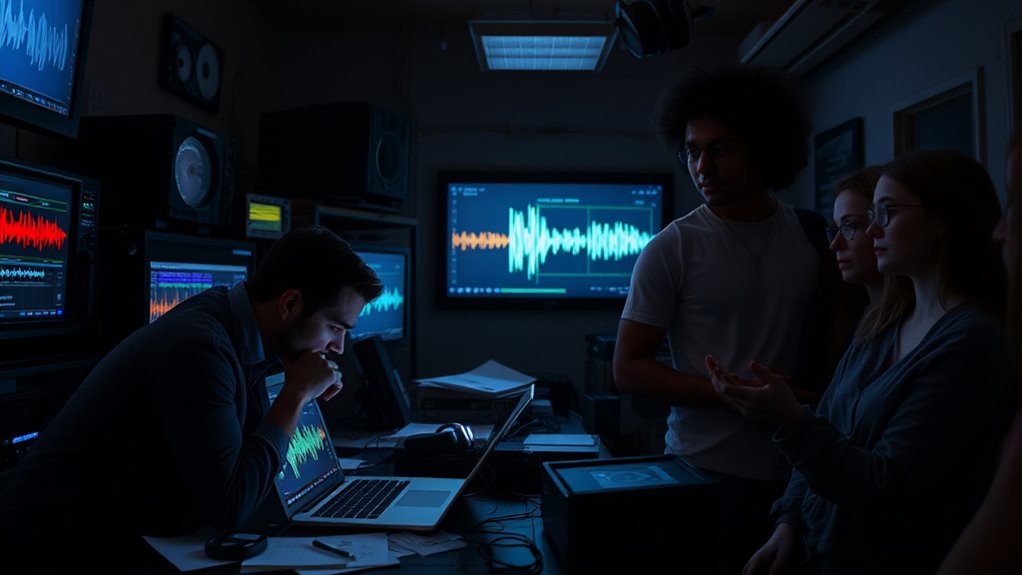
After gathering your audio evidence and analyzing it with the right tools, the next step is engaging in peer review. This process allows you to share isolated audio events with fellow investigators for insights and verification.
Here’s how to make the most of it:
- Document the classification of audio events for systematic comparisons.
- Cross-check findings to identify potential misinterpretations like matrixing.
- Maintain a Surveillance Log to track discussions and decisions.
- Encourage open dialogue and constructive criticism for rigorous analysis.
- Foster collaborative analysis to eliminate bias and enhance reliability.
Engaging in peer review not only strengthens your conclusions but also enriches your understanding of the audio evidence collected.
Documenting Findings and Insights

How can you effectively document your findings and insights from audio analysis? Start by maintaining a detailed audio review log, noting the date, time, and context of each recording. This will help you analyze patterns and comparisons later. Isolate electronic voice phenomena (EVP) by copying them to a new window, ensuring you include ambient noise for context. Use software like Audacity to visualize waveforms while keeping original recordings intact. Document any enhancements in your log, detailing the type and rationale for transparency. Finally, cross-reference your findings with peers to validate your interpretations.
| Date | Finding/Insight |
|---|---|
| 2023-10-01 | EVP captured at 3:15 AM |
| 2023-10-01 | Background noise noted |
| 2023-10-02 | Enhanced clarity on EVP |
| 2023-10-03 | Cross-referenced with peers |
| 2023-10-04 | Contextual analysis completed |
Frequently Asked Questions
Is There Any Real Evidence of Paranormal Activity?
You might wonder if there’s real evidence of paranormal activity. While many claim to have experienced it, scientific skepticism often challenges these assertions.
Most evidence, like strange sounds or sightings, can usually be attributed to natural causes. However, some recordings, such as EVPs, spark debate.
To determine their validity, you’ll need to analyze them carefully, considering environmental factors, quality, and potential misinterpretations before concluding whether they truly represent the supernatural.
How to Tell if Something Paranormal Is Happening?
When it comes to figuring out if something paranormal’s happening, you’ll want to keep your ear to the ground.
Look for strange sounds or voices that seem out of place, especially those you can’t explain. Pay attention to your surroundings, and trust your instincts.
If the hairs on your neck stand up, it might be time to investigate further. Always document your findings; you’ll want to connect the dots later.
What Do Ghost Hunters Use to Hear Voices?
Ghost hunters often use high-definition audio recording equipment to capture clear sounds and voices.
You’ll find that these devices help minimize background noise, making it easier to detect any unusual phenomena.
When reviewing recordings, headphones are your best friend; they allow you to focus on subtle details.
Many investigators also rely on sound editing software to visualize waveforms, which helps identify any anomalies that could indicate paranormal activity.
What Voice Recorders Do Paranormal Investigators Use?
Did you know that over 60% of paranormal investigators prefer using high-definition digital voice recorders for capturing EVP?
You’ll find models like the Zoom H1n Handy Recorder and the Tascam DR-05X are popular choices among ghost hunters. These devices offer user-friendly interfaces and excellent sound quality.
Many also opt for recorders with noise cancellation features to help isolate potential EVP, ensuring your investigations yield the best possible evidence.
Don’t forget to check battery levels!
Conclusion
In your quest to analyze audio for paranormal evidence, remember that each sound is a whisper from the unknown. By gathering the right equipment, reviewing your findings with a keen ear, and engaging in open dialogue with peers, you’ll sharpen your skills and gain deeper insights. Context is key, so never underestimate its power. As you document your journey, you may just uncover the secrets that lie hidden in the echoes of the past.




